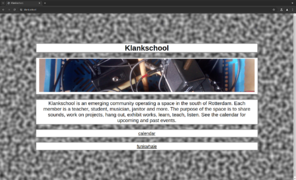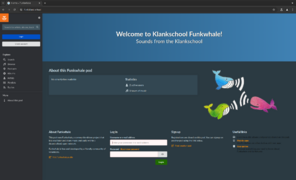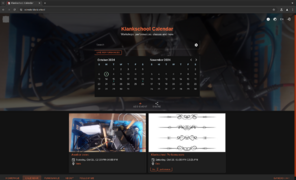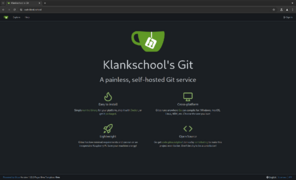User:Riviera/Project proposal: Difference between revisions
(Added text) |
m (add some images) |
||
| Line 7: | Line 7: | ||
Activity on WhatsApp and in person is ongoing regarding Klankschool. A space became available in August. Some people met up there infrequently. Out of those occasional meetings, in early October 2024, I decided to borrow a Mac Pro from the department and install Arch Linux on it. I smuggled the machine off-campus and connected it to the internet via the router at my flat. Inspired by months of murmurings, I began hosting a collection of containerised web services for Klankschool. This includes a federated audio sharing platform, a federated calendar, a Gitea instance, a collaborative live coding environment and more. | Activity on WhatsApp and in person is ongoing regarding Klankschool. A space became available in August. Some people met up there infrequently. Out of those occasional meetings, in early October 2024, I decided to borrow a Mac Pro from the department and install Arch Linux on it. I smuggled the machine off-campus and connected it to the internet via the router at my flat. Inspired by months of murmurings, I began hosting a collection of containerised web services for Klankschool. This includes a federated audio sharing platform, a federated calendar, a Gitea instance, a collaborative live coding environment and more. | ||
<gallery mode="packed-hover"> | |||
Image:Screenshot From 2024-10-07 08-08-24.png|Klankschool landing page|link=http://klank.school | |||
Image:Screenshot From 2024-10-07 08-08-35.png|Klankschool Funkwhale|link=http://funk.klank.school | |||
Image:Screenshot From 2024-10-07 08-08-51.png|Klankschool Calendar|link=http://calendar.klank.school | |||
Image:Screenshot From 2024-10-07 08-09-00.png|Klankschool Git|link=http://code.klank.school | |||
</gallery> | |||
Besides setting things up on the Klankschool server, I have been running a Nextcloud on a raspberry pi since April 2024. Since November 2024, this instance which I use for personal and research purposes is piggy-backing on the HUB. The HUB is a mesh network which Aymeric Mansoux set up at XPUB five years ago (Cochior et al., 2022, p. 9). Using Nextcloud reflects the extent to which I am immersed in FLOSS. Nextcloud enables me to keep my files backed-up, contacts in order and calendar appointments synchronised across my Linux laptop and Android phone. The server was offline for the duration of October so there was no synchronisation between my phone and laptop’s calendars, notes or media. I was busy emailing gnd, the XPUB system administrator, trying to add my Pi to the HUB. | Besides setting things up on the Klankschool server, I have been running a Nextcloud on a raspberry pi since April 2024. Since November 2024, this instance which I use for personal and research purposes is piggy-backing on the HUB. The HUB is a mesh network which Aymeric Mansoux set up at XPUB five years ago (Cochior et al., 2022, p. 9). Using Nextcloud reflects the extent to which I am immersed in FLOSS. Nextcloud enables me to keep my files backed-up, contacts in order and calendar appointments synchronised across my Linux laptop and Android phone. The server was offline for the duration of October so there was no synchronisation between my phone and laptop’s calendars, notes or media. I was busy emailing gnd, the XPUB system administrator, trying to add my Pi to the HUB. | ||
During October, eager to create a community space through maintaining digital infrastructure, I set up a variety of web services for Klankschool. I thus took on some responsibility in relation to the community. I feel obligated to look after these pieces of infrastructure insofar that other so-called Klankschoolers make use of them. This is most notable with the calendar, which describes itself as a calendar for the whole of Rotterdam. Stephen Kerr and Joseph’s enthusiasm for these digital developments inspired me to go further. | |||
Rosa is also part of Klankschool. In mid 2024 we produced a performance titled Printer Jam. It brought live coding software and abandoned hardware together to breathe life back into disused printers. Live Coding is a performance practice in which, with code, music or graphics are generated in real time before an audience (Ledesma, 2015, pp. 112–117). We gave the performance at Gulaschprogrammiernacht 22, in Karlsruhe, Germany. The video recording has been watched 245 times at the time of writing. She and I plan to collaborate on a series of in total 12 workshops. We worked together effectively in the past so I am optimistic about further collaboration. | Rosa is also part of Klankschool. In mid 2024 we produced a performance titled Printer Jam. It brought live coding software and abandoned hardware together to breathe life back into disused printers. Live Coding is a performance practice in which, with code, music or graphics are generated in real time before an audience (Ledesma, 2015, pp. 112–117). We gave the performance at Gulaschprogrammiernacht 22, in Karlsruhe, Germany. The video recording has been watched 245 times at the time of writing. She and I plan to collaborate on a series of in total 12 workshops. In terms of theme, the workshop series converges on a meeting point of our individual practice and research. We worked together effectively in the past so I am optimistic about further collaboration. | ||
Personally, I enjoy making performances with free / libre / open source software and my research currently revolves around servers. Thus, accompanying the workshops, I plan to write entries for a newsletter to keep people up to date with server-related goings-on. In terms of content, the newsletter may include pieces of text, sounds, algorithms or git repositories. That is to say, it draws the audience’s attention to various services already running on the klankschool server. It aims to offer coverage of what has taken place at Klankschool since the previous newsletter. The release date of the newsletter follows a lunar calendar. It will be published every Last Quarter Moon between December and June. The primary audience are people in the WhatsApp group. Although, the reach is potentially wider than that. decentral1se is boosting klankschool events on the Fediverse and knoflook may also share events on third-party websites. | Personally, I enjoy making performances with free / libre / open source software and my research currently revolves around servers. Thus, accompanying the workshops, I plan to write entries for a newsletter to keep people up to date with server-related goings-on. In terms of content, the newsletter may include pieces of text, sounds, algorithms or git repositories. That is to say, it draws the audience’s attention to various services already running on the klankschool server. It aims to offer coverage of what has taken place at Klankschool since the previous newsletter. The release date of the newsletter follows a lunar calendar. It will be published every Last Quarter Moon between December and June. The primary audience are people in the WhatsApp group. Although, the reach is potentially wider than that. decentral1se is boosting klankschool events on the Fediverse and knoflook may also share events on third-party websites. | ||
One material outcome of the workshops could be an album of sounds. Alternately, inspired by Bayliss et al. (2005), the workshops may culminate in a sonic performance involving bodies and sensors. That would reflect my curiosities about embodiment as a means of thinking through software (Con Diaz, 2015; Copraij et al., 2008). This subject is a stimulus for the first workshop I hope to lead on January 30th. | |||
Speaking of time, the timetable for our shared endeavours is a living document. A Gantt Chart will be publicly available at [https://openproject.klank.school/projects/general/gantt openproject.klank.school] for the duration of the project. There are advantages and disadvantages to using OpenProject. Personally, I think Gantt Charts will augment our productivity and I am in favour of a “live”, public facing, open and responsive timetabling system. Rosa and I agree to set aside time in December to further align our ideas. If we choose to lead between two and four workshops collaboratively, then there is a need to decide which these will be. | Speaking of time, the timetable for our shared endeavours is a living document. A Gantt Chart will be publicly available at [https://openproject.klank.school/projects/general/gantt openproject.klank.school] for the duration of the project. There are advantages and disadvantages to using OpenProject. Personally, I think Gantt Charts will augment our productivity and I am in favour of a “live”, public facing, open and responsive timetabling system. Rosa and I agree to set aside time in December to further align our ideas. If we choose to lead between two and four workshops collaboratively, then there is a need to decide which these will be. | ||
Latest revision as of 09:17, 20 November 2024
For any lived body, the world appears as the system of possibilities which are correlative to its intentions …. For any lived body, moreover, the world also appears as populated with opacities and resistances correlative to its own limits and frustrations. For any bodily existence, that is, an “I cannot” may appear to set limits to the “I can.”
Iris Marion Young, 1980, p.147
The idea of Klankschool, with a plan to move into a space close to Varia, brought people, myself included, together in early 2024. Joseph assures me the idea had been swirling around the sound-art community in Rotterdam for some time already. 45 people are amassed in a WhatsApp group chat which was created in April, although not by me. No-one could have predicted that a dispute over the upkeep of the building at the proposed location of Klankschool would disrupt moving-in plans. This transpired over the summer. The silver lining being that needing to pay a membership fee, to cover rent for a dedicated space, was postponed.
Activity on WhatsApp and in person is ongoing regarding Klankschool. A space became available in August. Some people met up there infrequently. Out of those occasional meetings, in early October 2024, I decided to borrow a Mac Pro from the department and install Arch Linux on it. I smuggled the machine off-campus and connected it to the internet via the router at my flat. Inspired by months of murmurings, I began hosting a collection of containerised web services for Klankschool. This includes a federated audio sharing platform, a federated calendar, a Gitea instance, a collaborative live coding environment and more.
Besides setting things up on the Klankschool server, I have been running a Nextcloud on a raspberry pi since April 2024. Since November 2024, this instance which I use for personal and research purposes is piggy-backing on the HUB. The HUB is a mesh network which Aymeric Mansoux set up at XPUB five years ago (Cochior et al., 2022, p. 9). Using Nextcloud reflects the extent to which I am immersed in FLOSS. Nextcloud enables me to keep my files backed-up, contacts in order and calendar appointments synchronised across my Linux laptop and Android phone. The server was offline for the duration of October so there was no synchronisation between my phone and laptop’s calendars, notes or media. I was busy emailing gnd, the XPUB system administrator, trying to add my Pi to the HUB.
During October, eager to create a community space through maintaining digital infrastructure, I set up a variety of web services for Klankschool. I thus took on some responsibility in relation to the community. I feel obligated to look after these pieces of infrastructure insofar that other so-called Klankschoolers make use of them. This is most notable with the calendar, which describes itself as a calendar for the whole of Rotterdam. Stephen Kerr and Joseph’s enthusiasm for these digital developments inspired me to go further.
Rosa is also part of Klankschool. In mid 2024 we produced a performance titled Printer Jam. It brought live coding software and abandoned hardware together to breathe life back into disused printers. Live Coding is a performance practice in which, with code, music or graphics are generated in real time before an audience (Ledesma, 2015, pp. 112–117). We gave the performance at Gulaschprogrammiernacht 22, in Karlsruhe, Germany. The video recording has been watched 245 times at the time of writing. She and I plan to collaborate on a series of in total 12 workshops. In terms of theme, the workshop series converges on a meeting point of our individual practice and research. We worked together effectively in the past so I am optimistic about further collaboration.
Personally, I enjoy making performances with free / libre / open source software and my research currently revolves around servers. Thus, accompanying the workshops, I plan to write entries for a newsletter to keep people up to date with server-related goings-on. In terms of content, the newsletter may include pieces of text, sounds, algorithms or git repositories. That is to say, it draws the audience’s attention to various services already running on the klankschool server. It aims to offer coverage of what has taken place at Klankschool since the previous newsletter. The release date of the newsletter follows a lunar calendar. It will be published every Last Quarter Moon between December and June. The primary audience are people in the WhatsApp group. Although, the reach is potentially wider than that. decentral1se is boosting klankschool events on the Fediverse and knoflook may also share events on third-party websites.
One material outcome of the workshops could be an album of sounds. Alternately, inspired by Bayliss et al. (2005), the workshops may culminate in a sonic performance involving bodies and sensors. That would reflect my curiosities about embodiment as a means of thinking through software (Con Diaz, 2015; Copraij et al., 2008). This subject is a stimulus for the first workshop I hope to lead on January 30th.
Speaking of time, the timetable for our shared endeavours is a living document. A Gantt Chart will be publicly available at openproject.klank.school for the duration of the project. There are advantages and disadvantages to using OpenProject. Personally, I think Gantt Charts will augment our productivity and I am in favour of a “live”, public facing, open and responsive timetabling system. Rosa and I agree to set aside time in December to further align our ideas. If we choose to lead between two and four workshops collaboratively, then there is a need to decide which these will be.
In summary, between January and June 2025, I propose to review facets of the Klankschool server with a view to keeping things simple. I want to handover the infrastructure to Klankschool members who can live in Rotterdam without needing a visa. To actualise that, I am guided by some constraints, some “I cannot”…. In recording the process of keeping things simple, I hope to document and share knowledge about how the server is set up. I desire to limit my involvement to the end of the academic year. As such, I would like to offer food for thought to others in similar positions attempting to setup shared infrastructure.
References
Bayliss, A., Sheridan, J. G. and Villar, N. (2005) ‘New shapes on the dance floor: Influencing ambient sound and vision with computationally augmented poi’, International Journal of Performance Arts and Digital Media, vol. 1, no. 1, pp. 67–82 [Online]. DOI: 10.1386/padm.1.1.67/1 (Accessed 20 November 2024).
Cochior, C., Mugrefya, elodie and Strete, A. (eds.) (2022) A Traversal Network of Feminist Servers, Bucharest, Fractalia.
Con Diaz, G. (2015) ‘Embodied Software: Patents and the History of Software Development, 1946-1970’, IEEE Annals of the History of Computing, vol. 37, no. 3, pp. 8–19 [Online]. DOI: 10.1109/MAHC.2015.45 (Accessed 20 November 2024).
Copraij, Jenniches and Kunzmann (2008) ‘Performance Documentation 5: Sensing presence no. 1: Performing a hyperlink system’, in Bleeker, M. (ed), Anatomy Live, Performance and the Operating Theatre, Amsterdam University Press, pp. 165–168 [Online]. Available at https://www.jstor.org/stable/j.ctt46ms7q.17 (Accessed 20 November 2024).
Ledesma, E. (2015) ‘The Poetics and Politics of Computer Code in Latin America: Codework, Code Art, and Live Coding’, Revista de Estudios Hispánicos, Washington University in St. Louis, vol. 49, no. 1, pp. 91–120 [Online]. DOI: 10.1353/rvs.2015.0016 (Accessed 20 November 2024).
Young, I. M. (1980) ‘Throwing like a Girl: A Phenomenology of Feminine Body Comportment Motility and Spatiality’, Human Studies, Springer, vol. 3, no. 2, pp. 137–156 [Online]. Available at https://www.jstor.org/stable/20008753 (Accessed 20 November 2024).




